![]()
![]()
![]()
Use LEFT and RIGHT arrow keys to navigate between flashcards;
Use UP and DOWN arrow keys to flip the card;
H to show hint;
A reads text to speech;
65 Cards in this Set
- Front
- Back
- 3rd side (hint)
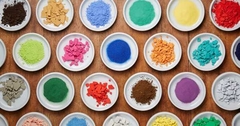
Pigments |
Intensely colored powders made from minerals, organic compounds, etc. which are ground to an extremely fine consistency.
|
|
|

Medium |
The actual material substance used to make a work of art. Plural for the word medium is media. The physical embodiment of the idea that can reinforce the artist concept of the artwork. |
|
|

Binders |
A substance into which a pigment is blended and which bind the powder together. |
|
|
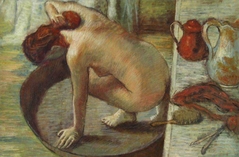
Pastel |
(Drawing) Colored sticks of pure pigment held together by a binder. Can be blended to look like paintings. |
|
|
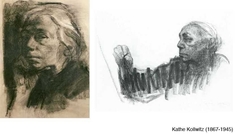
Charcoal |
-Drawing-
A prehistoric medium Charcoal is carbon made from burntwood. The softness of charcoal allows it to smudge so easily, he can create smooth gradations. It can sometimes look like a painting due to how well it can blend. |
|
|
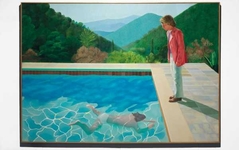
Acrylic |
Pigment + Synthetic polymer (plastic) Dries quickly into a flexible film. Soluble in water. Less toxic. Widely used beginning in the 1950’s. |
|
|
|
2 major aspects of art. Describe them. |
Form Refers to the physical nature of an artwork. (Sight, touch, smell, taste) FORMAL ELEMENTS include Line, shape, color, mass, volume, space, scale, motion, etc. -Composition (the arrangement) . - Materials from which the artwork is made.AESTHETIC- The way something looks.Content AESTHETIC- The way something looks.
Content The mass of ideas associated with the work of art What it means or what it's about The artist's ideas; an artist's CONCEPT. Interpretations. |
|
|
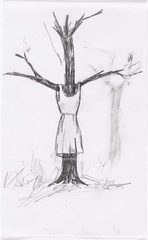
Pencil |
-DRAWING-
Pencils are made from a soft metal called graphite. The softer the graphite the darker the mark and vice versa. Hard media used mainly to create lines. |
|
|
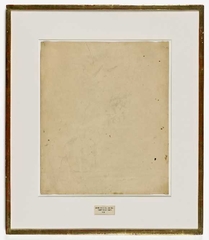
Erasers |
(Drawing) Used to create marks, and especially highlights, by removing another media. |
|
|
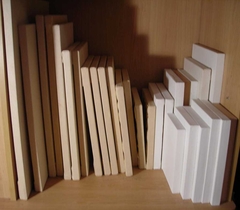
In painting what is a SUPPORT? |
The surface to which the paint is applied. A SUPPORT could be many things: stone, clay, plaster, wood panel, paper, fabric, found objects. |
|
|

In paintings what is a fresco? |
Pigment + Plaster
Fresco is used for large murals painted directly onto walls or ceilings.
|
|
|
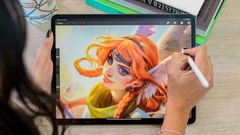
New technologies and experimental media in drawing |
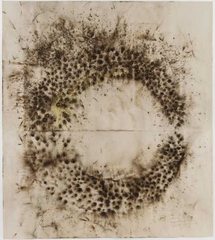
Technology provides new ways to produce drawings.The computer is a very helpful tool for creating images. Many artists use software that aids in drawing as well as design, animation, or painting. |
|
|
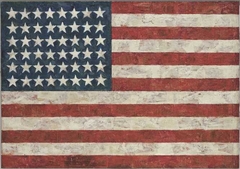
What is an encaustic painting? |
Pigment + Wax |
|
|
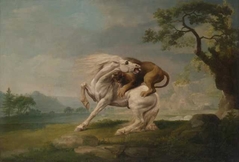
oil painting |
Pigment + oil
Flexible, slow drying, and can be blended days after application, allowing for smooth effects and fine detail |
|
|

Ink |
A wet (liquid) drawing media and is typically applied to paper with a brush or a specialized pen. Traditionally they have been black or brown, although modern inks can be colored. Ink dries or hardens as the liquid evaporates. Ink can be diluted with water to create many different shades of black and gray. Ink has been the traditional medium used by Chinese and Japanese painters. |
|
|
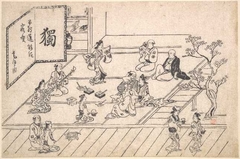
Paper |
(Drawing)
Drawings are commonly applied to a paper. Before the invention of paper, drawings were made on papyrus, cloth, wood, and animal hide (parchment and vellum) Paper is manufactured from pounded or macerated plant fibers and was invented in China around 2000 years ago. |
|
|
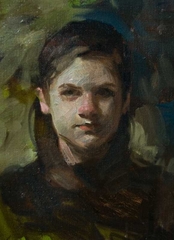
What is an Alla Prima oil painting? |
Oil paint can also be applied directly, without creating transparent layers, in a technique called ALLA PRIMA |
|
|
|
Relief Printing |
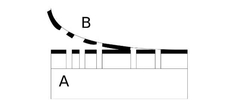
In RELIEF printing:
-Areas NOT to be printed are cut away from a block.
-The higher, original surface has ink applied to it. |
|
|
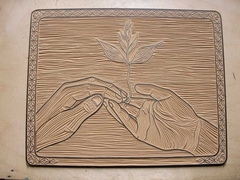
What is woodblock? |
WOODBLOCK (or WOODCUT) is the most common process of RELIEF printmaking. A flat block of wood is carved away, leaving the remaining surface to produce the image. The artist carves away what they DON’T want printed, leaving the flat top surface of the woodblock to receive the ink. |
|
|
|
Intaglio Printmaking |
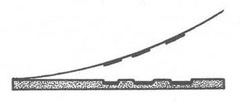
In INTAGLIO printing: Fine, linear grooves are created on a flat metal (or plastic) plate. Ink is rubbed into the grooves, and rubbed off of the surface. So in intaglio printmaking you carve what you DO WANT to be printed.
Can be very detailed, and can look a lot like drawings, because they are made up of lines. |

|
|
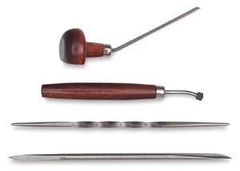
Two Types of Intaglio Printmaking processes. |
ENGRAVING – lines are carved into a plate. Engraving is how they make the pictures on our money.
ETCHING – lines are made by scratching through a protective coating on a plate. The plate is put in an acid bath, which eats away (“etches”) the exposed lines. |
|
|
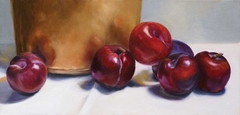
What is glazing in oil painting? |
Applying many layers of transparent paint (called GLAZES), to create luminous colors.
Transparent layers of color are applied to a black and white under painting. |
|
|

What is Lithography Printmaking? |
In Lithography, traditionally, an image is drawn or painted onto a limestone slab with an oily medium, the stone is treated with a chemical, and the original drawing is removed.
The chemical makes it so ink sticks to the marks but not anywhere else. There’s no carving or scratches. It’s still flat.
Lithography is extremely versatile and can produce a very wide range of marks, from fine lines and flat areas of color, and marks that closely resemble drawings and paintings (because they are produced by drawing or painting onto the stone). As with all printing, each color must be created and printed separately. |
|
|
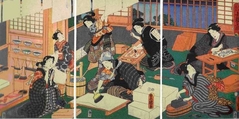
Printmaking |
The process of making an image using one surface to transfer ink onto another surface.
The resulting image is called a PRINT.
The set of prints produced of a particular image (or a multiple in any medium) is called an “EDITION”. Often, the ink is transferred onto the paper by means of a PRESS. |
|
|
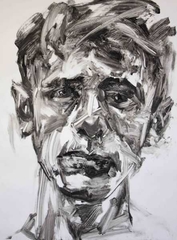
What is monotype lithography? |
MONOTYPES make only one impression of an image, not multiples. (“Mono” means “one”) |
|
|

Painting |
Paint consists of two basic components: a pigment and a binder* (also called a “vehicle”). The same pigment can be used with different binders. The binder is what determines which kind of paint it is (and what we call it). |
|
|
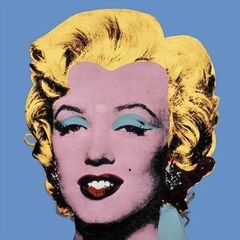
What is Serigraphy printmaking? |
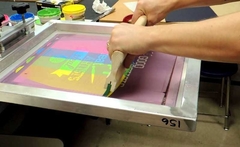
SERIGRAPHY is also called SCREEN PRINTING, or SILK SCREEN. Unlike the earlier categories of printmaking, screen printing does not use a rigid block or plate, or even a printing press.
SERIGRAPHY uses a piece of finely woven fabric (a screen) stretched around a frame. A fluid, light-sensitive, plastic-like stencil is coated to the screen and allowed to dry. The coating/stencil seals the fabric screen. A design can be applied to the screen, which is then exposed to light, and the design removed. The areas where the design was applied will wash out with water.
Wherever there is no stencil (because it was washed out of the screen), the ink can get pushed/scraped through the fabric and onto the paper, fabric, etc.
SERIGRAPHY /SCREEN PRINTING is best at big flat areas of color, but not as good at fine lines. |
|
|
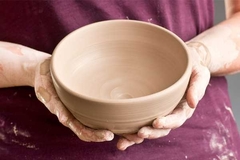
Crafts |
Objects for ceremonial or everyday use. "distinguished" from high (not considered) art in the western culture. |
|
|
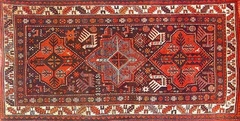
Textiles |
TEXTILES as an art medium (aka, “textile art” or “fiber arts”), refers to the use of textiles (felt, fibers, fabrics), and their related processes (sewing, quilting, knitting, etc.), to create artworks. |
|
|
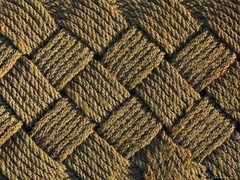
Woven |
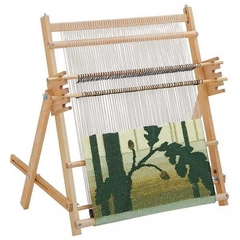
Fabrics are WOVEN if they are made by weaving together threads at 90° to each other. This can be done by hand, using tools, or most commonly with a machine called a LOOM. Looms can range from being very simple to huge, complicated, industrial equipment. |
|
|
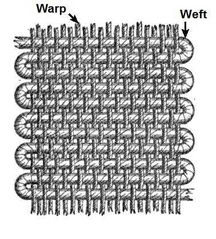
WARP & WEFT |
The threads running the length of the woven fabric are called the WARP. The threads running the width of the fabric are called the WEFT. |
|
|
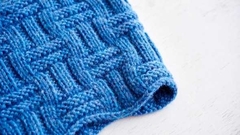
Knitting |
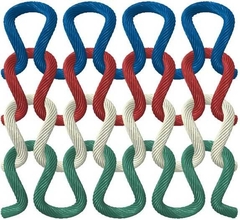
Fabrics can also be KNITTED using a thread that interlocks with itself using many loops. |
|
|
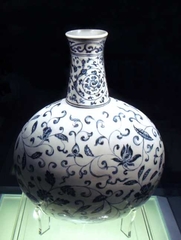
Ceramics |
A sculpted clay object can be heated (“fired”) in a special furnace called a KILN, which hardens it more than is possible with just air-drying. The resulting material is either called CERAMIC, PORCELAIN, EARTHENWARE, STONEWARE, etc. depending on the different ways it was made and the type of clay. |
|
|
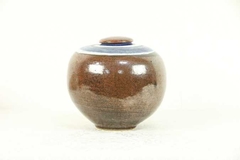
(Ceramic) Glaze |
A special coating can be applied to color, decorate, or seal previously fired clay objects. This coating is called a GLAZE. The coated object is fired again and the glaze melts/bonds to the object. |
|
|
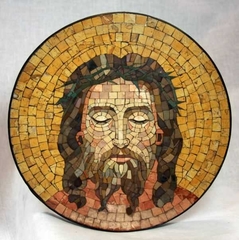
Mosaic |
MOSAIC images are created by using small pieces of colored glass, shell, ceramic, or stone that are pressed into a wet mortar that had been applied to a surface, typically an architectural surface such as a wall or ceiling. |
|
|
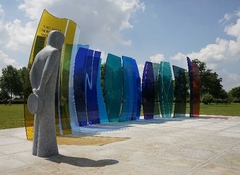
(3D ART/SCULPTURES) Freestanding |
Objects you could walk around and see from all sides. |
|
|
|
(3D ART) Relief Sculpture |
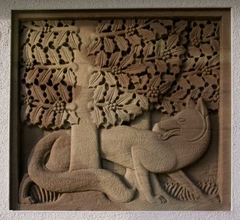
Projects out from a flat surface, such as a wall, and is seen only from one angle. |
|
|
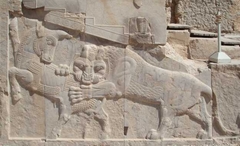
BAS-RELIEF |
In BAS-RELIEF (or Low Relief) the sculptor’s marks are shallow, maybe only a centimeter to a few inches. Mostly uniform depth. Bas (pronounced “bah”) means “low” in French. |
|
|

High-Relief |
When a sculptor chooses to carve more deeply, he or she is working in “HIGH RELIEF”. High relief might be from a few inches to a foot or more. Various depths. |
|
|
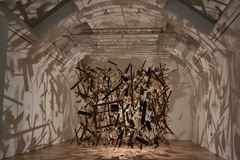
(3D ART) Site Specific sculpture |
SITE-SPECIFIC sculpture is specifically designed for a particular place (site). The surrounding environment becomes part of the experience of the artwork. |
|
|
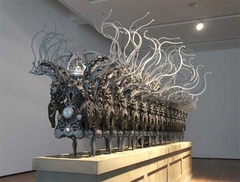
(3D ART) Kinetic |
In KINETIC sculpture, actual movement is part of the piece. |
|
|
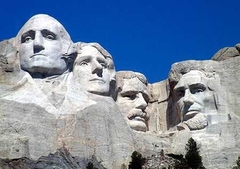
Carving |
Carving is a method for creating 3-D work where artists remove unwanted material. Traditionally this would be made from a large block of stone or wood. |
|
|

(3D ART) Modeling |
MODELING is the method of pushing, pulling, or otherwise shaping a malleable substance, such as clay or wax. Ceramics would be a made using modeling. |
|
|
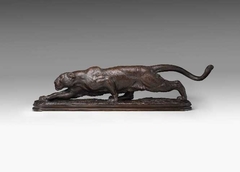
Cast or casting |
CAST objects are made by: first creating a model, surrounding it with a MOLD, removing the model, then filling (casting) the mold with another material to make a final product (called a CAST) that is a copy of the original. You can cast sculptures using many materials, such as metal, foam, or plastic. The casting material starts as a liquid, then hardens |
|
|
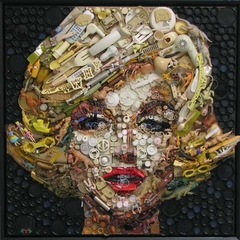
Assembling |
Assembling is a process used to create many sculptures or other functional objects. objects. In art, they are sometimes called ASSEMBLAGES.
Assembled sculptures are often MIXED MEDIA, which literally means mixing up methods and their various media in a single work. Many times FOUND OBJECTS are incorporated into assembled works. Found objects are simply that: objects that an artist finds and repurposes them for an artwork. |

|
|

Fabrication |
Sculptures can also be FABRICATED, meaning industrial and commercial processes, such as welding or neon lighting, were used in production.
FABRICATED artworks often require specialized equipment and expert knowledge the artist doesn’t have. |
|
|
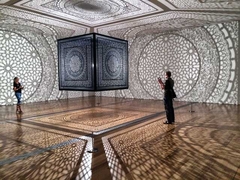
Installation |
Installation is a category of 3D art that fits somewhere between sculpture and architecture. They are often mixed-media artworks that fit or fill an architectural space and can create their own environment. Some might be site-specific |
|
|

(ARCHITECTURE) Load-Bearing |
LOAD-BEARING construction is a very direct process. It’s basically piling one stone or brick on top of another. In load-bearing construction, all areas of the walls support the structure above them. The walls have few openings, because it needs to be strong enough to support everything else. Massive load-bearing works have been built throughout history |
|
|
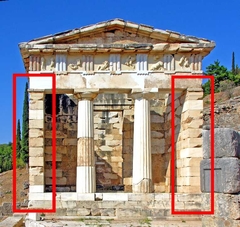
Post and Lintel |
POST-AND-LINTEL Construction is an ancient method of constructing walls, making openings, and supporting a roof. The basic module is two upright POSTS supporting a cross beam, called a LINTEL. |
|
|
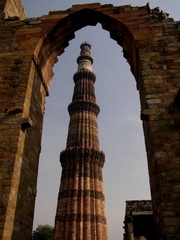
Corbeled Arch |
A CORBELED ARCH is made by the progressive cantilevering of stones above a load-bearing wall or posts. It was used in many cultures throughout the world. While it is structurally stronger than post-and-lintel, it is not as strong as a “true” arch. In a “true” (rounded) arch, tension is directed from a keystone in the top of the arch down to the ground along vertical posts (or pillars, etc.) |
|
|
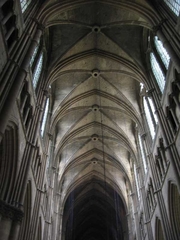
Vault |
A VAULT is an arch that has been extended to create an open space overhead. There are different shapes of vaults, just like there are different shapes of arches. |
|
|

Flying buttress |
Toward the end of the European Middle Ages, a development called a FLYING BUTTRESS allowed the walls to be supported without having to be load-bearing. This allowed the size of windows to be enlarged, and making stained-glass windows possible. |
|
|
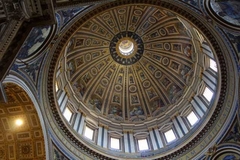
Dome |
Structurally, a DOME is like an arch that has been rotated 360° on its vertical axis. Domes are a very strong structure and can span large areas because the weight is dispersed outward toward the walls. |
|
|
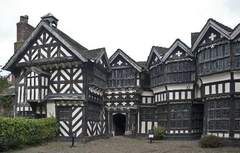
Timber frame |
TIMBER FRAME construction was also widely used throughout the ancient world. Chinese culture (and the many Far Eastern cultures influenced by it) used a complex system of interlocking timbers that allowed for a curved roof, extremely wide eaves, and greater height because of the light weight. Walls were not load-bearing. |
|
|
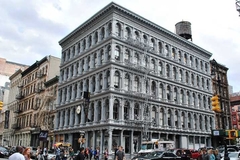
CAST IRON |
CAST IRON has been available since ancient times, but it was not until the 18th century that it could be melted in large quantities for building. |
|
|
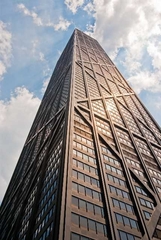
STEEL-FRAME CONSTRUCTION |
Modern steel, a metal alloy, is made from iron and a small quantity of carbon. Steel is stronger than pure iron and had even greater potential for architecture. STEEL-FRAME CONSTRUCTION made possible taller structures than anything ever built before, such as the gleaming, modern skyscraper. |
|
|

Reinforced concrete |
Concrete is a mixture of cement and ground stone and had been used since the ancient Roman empire. Modern REINFORCED CONCRETE is reinforced through the use of a fibrous material or steel rods (called “rebar”) to prevent cracking. It can also be poured into a “form” (a mold) to create shapes. |
|
|
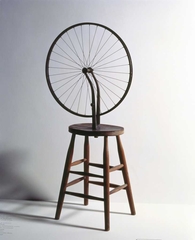
(New Media) Readymades |
Objects found in the world rather than ones made by the artist made into art. |
|
|
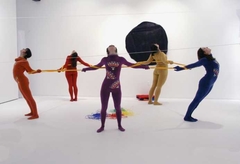
PERFORMANCE |
PERFORMANCE is a live-action event staged as an artwork. The human body is the prime element in performance art, but performance could also be mechanical or digital. |
|
|
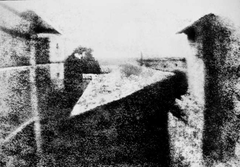
Photography |
In PHOTOGRAPHY a light-sensitive surface is exposed through a lens and creates an image on the surface of the environment. |
|
|

DAGUERREOTYPE |
Early photography made one-of-a-kind images, such as this DAGUERREOTYPE (pronounced “dug air oh type”). Daguerreotypes are unique images that are made on polished metal plates inside the camera. |
|
|
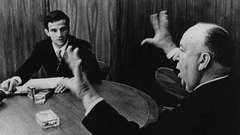
(Film & Video) Auteur |
During the mid 20th Century, film theorists developed the idea of the “Auteur” film (“Ah toor”; french for “author”). The theory proposes that certain popular, narrative films are works of art because they are the realization of a director’s creative vision. Proponents focus on the artistic vision of the director. The theory is controversial because movies are collaborative, and so it’s difficult to give all the credit to one person. |
|
|
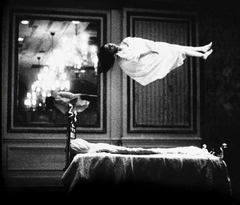
Experimental |
Experimental films often: • Use new technology or new subject matter • Are visually compelling and poetic • notable for their unusual content and idiosyncrasy • Low-budget formats • Innovative approaches (dream sequences, fantastic imagery) • Do not rely on narratives, the way popular films do |
|
|
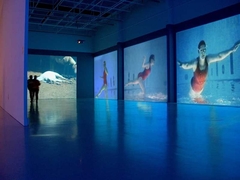
Video Art |
VIDEO ART is often made for galleries or art events and shown on television monitors or projected onto walls. It may transform a space by creating an environment and is marked by artistic experimentation. |
|
|
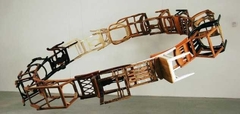
Conceptual |
CONCEPTUALISM is a movement beginning around 1960 and is very influential to contemporary art. The movement asserts that the artist’s idea, or concept, is of primary importance. Some works exist solely as ideas, but most have some form.
CONCEPTUAL ART doesn’t have any specific material that it uses. It uses lots of different stuff. The artist’s concept is what is most important.Conceptual artwork can be more difficult to understand and might require a greater investment of time to view and/or research what the artist was trying to accomplish. |
|

